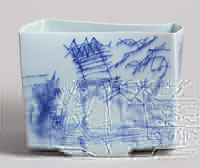|
Hidden Gems in Clay
The Gisela Freudenberg Collection
By ROBERT YELLIN
for the Japan Times, June 29, 2005
|
|

Yoshikawa Masamichi's
cubic porcelain vessel
with celadon glaze from 1991-2
|
|
|
|
|
Any new publication on Japanese ceramic art in English is a welcome addition to the few books on the subject. Like "Masterpieces of Modern Japanese Pottery from the Gisela Freudenberg Collection" currently showing in Frankfurt, Germany, many of these publications coincide with exhibitions and serve to educate the visitor on Japanese ceramic art information. This time the new tie-in book is from Germany, highlighting a private collection put together over three decades and now showing at the Museum fur Angewandte Kunst, Frankfurt, Germany until Aug. 28, 2005.
"The Fascination of Ceramics: Masterpieces of Modern Japanese Pottery from the Gisela Freudenberg Collection" is divided, like the exhibition, into six thematic sections:
- Masterpieces of
Living National Treasures
- Folk Kilns
- Six-Old Kilns
- Major Individualists
- Sculptural Ceramics
- Painted Wares
The hardcover publication has an austere Bizen vase on the cover -- the work of late living national treasure Yamamoto Toshu. This gives a taste of the choice of pots within the Freudenberg Collection, with most being sublime and moody chatou (tea wares.)
It is a salient point of the collection, one which shows a rare understanding of wabi-sabi aesthetics and does not rely heavily on cliched colorful export porcelains. That said, a collector who only visits these shores occasionally is still at the whims of what the potter, or dealer, has available at that point in time, so a collection, like the Freudenberg, formed in such a hit-or-miss way, is often quite uneven.
There are some contemporary masterpieces, such as four plates by LNT Shimaoka Tatsuzo; a Bizen chawan by Takahara Shoji; an Iga chawan by Kishimoto Kennin; and a celadon bowl by Fukami Sueharu. Unfortunately that is not the case for the core collection. For the most part these are of the good-to-better variety. Take, for instance, a large vase (number 2-2 in the book) by the internationally celebrated Hamada Shoji. The form is good and certainly does represent Hamada, yet the pitiful brushwork is second-rate and I wonder if this piece was ever meant to be displayed at all. Hamada had some of the finest brushwork techniques ever and thus seeing this piece leaves me more than a bit bewildered.
So-called "folk kilns" are represented in the collection by 28 pieces (most very run-of-the mill) from Hamada's star pupil Shimaoka Tatsuzo, and by four three-colored platters and a vase from Seto's Mizuno Hanjiro -- hardly enough of a selection to merit a whole section of its own.
The same goes for the four pieces by two artists in the "Painted Wares" section. One of the larger focuses of the collection is on the "six ancient kilns" that are Bizen, Tamba, Echizen, Seto, Tokoname and Shigaraki. Freuddenberg stands out among Japanese collectors as she took it upon herself or via her dealers to travel the back roads of Japan to locate these "dirty" wares.
We find good Bizen examples by Takahara and Yamamoto, yet the two chawan by current LNT Isezaki Jun are bland and uninspired. Isezaki's two mizusashi (water jars) are decent examples of Momoyama Period-inspired Bizen and his one pear-shaped vase is rather elegant. For Shigaraki there are some refined examples of chatou by Ueda Naokata V; brilliant natural ash-glazed pieces by Kanzaki Shiho (and a rare Shino chawan by this artist); a fantastic paddled-etched jar by Otani Shiro (outside link), and a to-die-for guinomi (sake cup) by Tsuji Seimei; the rest of the selection -- 23 works -- are all standard Shigaraki fare.
The highlight of the exhibition belongs to one ceramic artist alone -- Nara-based Tsujimura Shiro. He has 15 pieces in the book -- all truly magnificent -- from his small white slip kohiki guinomi to his "chilled and withered" Shigaraki chawan, and lastly his massive fissured Iga vase. Tsujimura's works exude a naturalness and energy unrivaled in Japan today and he deserves the following he has attracted worldwide. A few outstanding sculptural pieces round out the book, including the 1982 "S and Bible" by the late Araki Takako (she and Tsuji Kyo being the only two women artists represented), and a deceptive "paper ceramic" object that deceives the viewer into believing the clay work is actually tissue paper.
The works are photographed in crisp color and some historical ones are shown in black and white to highlight points in the essays. A few of these black-and-white photos are fuzzy and seem to have been processed without much care. Despite the overall lack of truly outstanding works, the book is a collector's item. It contains five insightful essays on how the collection was formed and a good essay by Brian Moeran on mingei potters. It also has useful information resources, such as a list of artists' names along with a paragraph or two of stylistic background in English next to their kanji, biographical data, signed box photos and a glossary.
"The Fascination of Ceramics: Masterpieces of Modern Japanese Pottery from the Gisela Freudenberg Collection" can be ordered directly from the museum by
faxing (00 49) 69-212-30703 or by sending an email to:
The cost of the book is 28 euros plus shipping.
Museum fur Angewandte Kunst
Frankfurt Schaumainkai 17-60594 Frankfurt-am-Main
Tel: (+49) 069 212-340 37 Fax: (+49) 069 212-307 03
Web Site: www.museumfuerangewandtekunst.frankfurt.de
After Frankfurt the exhibition will travel to the Museum of East Asian Art, Cologne, Germany, from Feb.4 through April 30, 2006, and then to Geneva, Switzerland, at the Les Collections Baur from May 19 to August 20, 2006.
The Japan Times: June 29, 2005
(C) All rights reserved

Click here for
index to all
Yellin stories for
The Japan Times
|